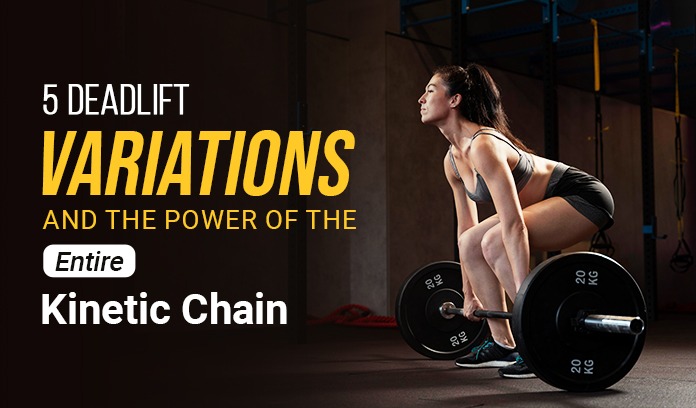Hafthor Bjornsson, the Icelander famous for strongman records and playing a massive warrior on Game of Thrones, has the world record for the deadlift—at 501 kilograms.
For laymen like you and me, that’s probably out of reach!
But the deadlift is a lower-body generator. Engaging multiple muscle groups, it is renowned for developing huge strength throughout the lower part of the kinetic chain. By targeting the muscles of the lower body, core, and upper body, deadlift variations offer a comprehensive workout that promotes full-body strength, stability, and coordination.
In this blog post, we will explore five deadlift variations and delve into the power of the entire kinetic chain. Understanding the importance of the kinetic chain and incorporating these variations into your training routine can help you maximize your strength gains and overall performance.
#1 Conventional Deadlift:
The conventional deadlift is the most common variation and forms the foundation for other deadlift variations. It primarily targets the posterior chain, including the glutes, hamstrings, and lower back, while engaging the core and grip strength.
- Start with your feet hip-width apart, toes under the barbell.
- Grip the bar with your hands slightly wider than shoulder-width apart.
- Keep your back straight, chest lifted, and engage your core.
- Push through your heels, lift the barbell by extending your hips and knees, stand tall.
- Lower the barbell back to the ground with controlled form.
#2 Sumo Deadlift:
The sumo deadlift variation places more emphasis on the inner thighs, quads, and glutes while reducing stress on the lower back. It also challenges your hip mobility and flexibility.
- Set up with your feet wider than shoulder-width apart and toes pointed outward.
- Grip the barbell with your hands positioned inside your legs.
- Keep your back straight, chest lifted, and engage your core.
- Drive through your heels, lift the barbell by extending your hips and knees, and stand tall.
- Lower the barbell back to the ground, maintaining proper form.
#3 Romanian Deadlift (RDL):
The Romanian deadlift primarily targets the hamstrings and glutes while engaging the lower back and core. It emphasizes the eccentric (lowering) phase of the lift.
- Start with your feet hip-width apart, holding the barbell with an overhand grip.
- Keep your back straight, shoulders retracted, and core engaged.
- Hinge forward at the hips, lowering the barbell along your legs, maintaining a slight bend in your knees.
- Feel a stretch in your hamstrings, but avoid rounding your back.
- Drive through your heels and extend your hips to return to the starting position.
#4 Single-Leg Deadlift:
The single-leg deadlift variation challenges balance, stability, and unilateral strength. It targets the glutes, hamstrings, and core while enhancing proprioception.
- Begin by standing on one leg with a slight bend in the knee.
- Hold a dumbbell or kettlebell in the opposite hand of the supporting leg.
- Hinge forward at the hips, extending the non-supporting leg backward for balance.
- Lower the weight toward the ground, keeping your back straight and hips square.
- Push through the heel of the supporting leg and engage your glutes to return to the starting position.
#5 Trap Bar Deadlift:
The trap bar deadlift variation provides a more upright torso position, reducing stress on the lower back. It targets the same muscle groups as the conventional deadlift but offers a slightly different movement pattern.
- Stand in the center of the trap bar, feet hip-width apart.
- Grip the handles with an overhand grip.
- Keep your back straight, shoulders retracted, and core engaged.
- Drive through your heels, extend your hips and knees, and stand tall.
- Lower the bar back to the ground with controlled form.
Conclusion:
Incorporating deadlift variations into your training routine can unlock the power of the entire kinetic chain, leading to increased strength, power, and overall athletic performance.
The conventional deadlift, sumo deadlift, Romanian deadlift (RDL), single-leg deadlift, and trap bar deadlift target various muscle groups while engaging the core, enhancing stability, and promoting full-body coordination.
Remember to start with lighter weights, focus on proper form, and gradually increase the load as you progress. By harnessing the power of the entire kinetic chain through these deadlift variations, you can elevate your strength training, build functional strength, and unlock your full potential.

